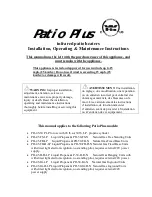
5 Installation
10
Installation and maintenance instructions uniSTOR 0020221302_02
age point. According to the table, the maximum permiss-
ible resistance for a straight length of a 22-mm-thick cop-
per discharge pipe
(D2)
of a thermal expansion relief valve
G1/2 is 9.0 m. The resistance of the four 22 mm elbows,
which are each 0.8 m in length, must be subtracted from this,
i.e. a total of 3.2 m. The maximum permitted length is ac-
cordingly 5.8 m and is therefore below the current length of
7 m. The calculation must therefore be performed using the
second largest size. The maximum permissible resistance
for a straight length of a 28-mm-thick pipe
(D2)
of a thermal
expansion relief valve G1/2 is 18 m. The resistance of the
four 28 mm elbows, which are each 1.0 m in length, must be
subtracted from this, i.e. a total of 4.0 m. The maximum per-
mitted length is accordingly 14 m. As the current length is
7 m, a 28 mm copper pipe
(D2)
should be selected.
A suitable location for the discharge pipe terminal is, for
example, beneath a fixed mesh above the odour trap in a
soakaway with a siphon. Low drain pipework, for example
up to 100 mm above external surfaces (car parks, mead-
ows, etc.) can be used provided that it is protected by a wire
fence or something similar to prevent children from coming
into contact with the waste water and provided that the sys-
tem is not visible. Do not install any valves or stopcocks on
the drain pipework.
Make sure that the discharge pipe from the tundish to the
drain has a constant downward gradient of at least 1:200.
The discharge pipe for the heat generator expansion relief
valve can be connected to the horizontal discharge pipe for
the cylinder behind the tundish using a T-piece.
5.2.4.1 High-level drain
Installing the highest drain is permitted as long as this does
not present a danger to anyone in or outside the building at
the drain point. Examples of points to consider when decid-
ing whether a location is suitable for the highest drain:
–
The possibility (taking the wind into account) that a per-
son might stay in the area where the water is drained
for a prolonged period of time, and, if this is the case,
whether the water is sufficiently cooled by that point to
pose no danger. The thermal conductivity of the material
surfaces, the climatic conditions, the installation location
and the drain pipework direction can, to different extents,
contribute to reducing the temperature of the water that is
being drained.
–
The position of the windows and other openings.
–
The probability of prams being under the drain opening.
–
The resistance of the surface to hot water.
–
The possibility of ice forming if water drains onto access
paths.
5.2.5
Installing the temperature sensor for the
immersion heater
Note
The temperature sensor is used to control the
immersion heater via a multi-functional module
or a control.
Validity:
Except for VIH GB 120/3 BES
OR Except for VIH GB 150/3 BES
Condition
: With a multi-functional module or control
▶
Secure the temperature sensor.
Validity:
VIH GB 120/3 BES
OR VIH GB 150/3 BES
Condition
: With a multi-functional module or control
▶
Secure the temperature sensor.
Summary of Contents for uniSTOR VIH GB /3 BES Series
Page 23: ......










































